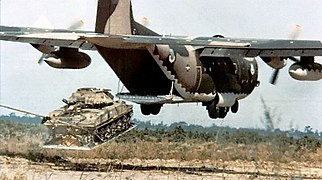Airdrop

An airdrop is a type of airlift in which items including weapons, equipment, humanitarian aid or leaflets are delivered by military or civilian aircraft without their landing. Developed during World War II to resupply otherwise inaccessible troops, themselves often airborne forces, airdrops can also refer to the airborne assault itself.
History
Early airdrops were conducted by dropping or pushing padded bundles from aircraft.[1] Later, small crates fitted with parachutes were pushed out of aircraft side cargo doors. Later, cargo aircraft were designed with rear access ramps, lowerable in flight, that allowed large platforms to be rolled out the back.
As aircraft grew larger, the
Airdrops evolved to include massive bombs as payload. The 15,000-pound (6,800 kg)
airdropped weapons.In 2021, the
In peacekeeping and humanitarian operations, food and medical supplies are often airdropped from United Nations and other aircraft.
Types
The type of airdrop refers to the way that the airdrop load descends to the ground. There are several types of airdrop, and each may be carried out using different methods.[3]
- Low-Velocity Airdrop is the delivery of a load involving parachutes that are designed to slow the load down as much as possible, ensuring that it impacts the ground with minimal force. This type of airdrop is used for delicate equipment and larger items such as vehicles.
- High-Velocity Airdrop is the delivery of a load involving a parachute meant to stabilize its fall. The Low-Altitude Parachute Extraction System (LAPES) is a variation of the high-velocity drop in which aircraft come close to carrying out a touch-and-go landingwithout actually touching the ground, ejecting their load at an extremely low altitude (as shown in the photo below of a C-130 airdropping a tank).
- Free-Fall Airdrop is an airdrop with no parachute at all. A common example of this type of airdrop is the delivery of airborne leaflet propaganda used in psychological warfare or the Triwall Aerial Delivery System (TRIADS).
Methods
The method of airdrop refers to the way the load leaves the aircraft. There are three main airdrop methods currently used in military operations.
- Extraction airdrops use an extraction parachute to pull the load out of the end of the aircraft: the parachute is deployed behind the aircraft, pulling the load out before cargo parachutes slow its descent. Extraction drops are usually low-velocity airdrops, with rare exceptions (e.g. LAPES).
- Manual Extraction airdrops, where the load is physically pushed out of an aircraft by a specially trained crew of up to four people.
- Gravity airdrops use the attitudeof the aircraft at time of drop to cause loads to roll out of the plane like a sled down a hill. The most common use of a gravity airdrop is the Container Delivery System (CDS) bundle.
- Door bundle drops are the simplest of airdrop methods: the loadmaster simply pushes out the load at the appropriate time.
Historically,
-
Gravity airdrop of CDS bundles from aC-17
-
Extraction airdropping a light tank
-
Airdropped humanitarian supplies being recovered in Haiti, 2010
-
-
Food supply crate mounted under a German He 111 bomber, 1944
See also
References
- Technical Order (TO)13C7-1-11 Airdrop of Supplies and Equipment: Rigging Containers. Department Of The Air Force. September 2005.
- Technical Order (TO)13C7-1-5 Airdrop of Supplies and Equipment: Rigging Airdrop Platforms. Department Of The Air Force. August 2001.
- ^ "Help From The Skies", November 1929, Popular Mechanics
- ^ "Rapid Dragon's first live fire test of a Palletized Weapon System deployed from a cargo aircraft destroys target". Air Force Material Command. Air Force Research Laboratory Public Affairs. December 16, 2021. Retrieved 2022-07-23.
- ^ "FM 10-500-1 Principles of Airdrop Supply and Resupply Operations", GlobalSecurity.org
External links
- 47 Air Despatch Sqn RLC The British Army's only remaining unit specialising in airdrop.
- Airdrop of Supplies and Equipment: Rigging Loads for Special Operations Headquarters, Department of the Army, United States Marine Corps, Department of the Navy, Department of the Air Force.




